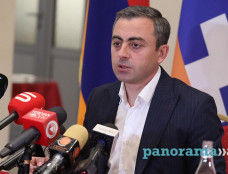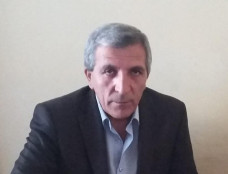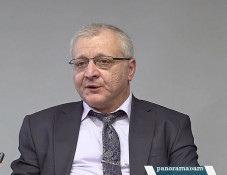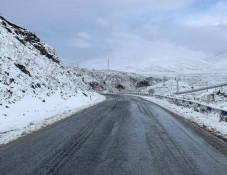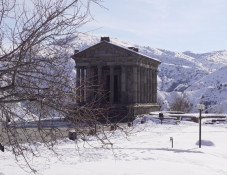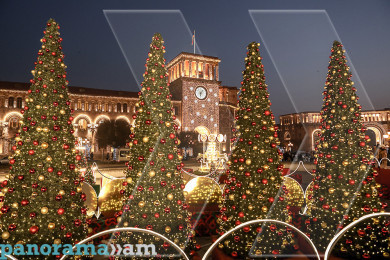
Rouben Galichian compiles evidence on Armenian presence in Caucasus from Greco-Roman sources of C5-1 BC
A more reliable classical source on the Armenian presence in the region than Herodotus (c. 484-425 BCE) known as the father of historiography is difficult to find. In eight pages of his Histories he writes about the Armenians and Armenia, as located in the area north of the Euphrates, according to the famous cartographer Rouben Galichian’s book Historical and Geographical Falsifications of Azerbaijan, a historical, cultural and cartographical research based on a detailed analysis backed by documentary evidence.
“When writing about Parthia, he mentions neighbouring Media, which was not yet named Atropatene, but in his work there is no mention of Albania or, for that matter, Aghvank,” Galichian writes.
The German cartographer Charles Muller produced a map of the ancient world according to Herodotus, compiled directly from the descriptions found in the Histories. According to the map taken from Atlas of Ancient Geography, Armenia and neighbouring Media existed during Herodutus’ times making up an area which was later called Atropatene.
Next, Galichian refers to one of the best-known Greek scholars, the historian and geographer Strabo (c. 64-25 BCE), whose 17-volume work Geographia has reached us intact. These volumes contain historical and geographical texts describing the world in as much detail as was known at the time. The volumes include no less than 60 references and detailed descriptions of Armenia and the Armenians. Albania, Iberia and Media are also often mentioned there. On the subject of the location of Albania and its borders, Strabo writes:
“They [the Albanians] live between the Iberians and the Caspian Sea, their country bordering on the sea towards the east and on the country of the Iberians towards the west. Of the remaining sides the northern is protected by the Caucasian Mountains (for these mountains lie above the plains, though their parts next to the sea are generally called Ceraunian), whereas the southern side is formed by Armenia, which stretches alongside it [Albania]…”
The fourteenth chapter of Book 11 is dedicated to Armenia, describing its topography, nature, geography, people and their customs and lifestyle, as well as related key historical events.
Regarding the borders of Armenia, Strabo states: “As for Armenia, the southern parts of it have the Taurus [mountains] situated in front of them, which separates it from the whole of the country between the Euphrates and the Tigris, the country called Mesopotamia; and the eastern parts border on Greater Armenia and Atropatene; and on the north are the mountains of Parachoathras that lie above the Caspian Sea, and Albania, and Iberia, and the Caucasus, which last encircles these nations and borders on Armenia, and borders also on the Moschian and Colchian mountains as far as the Tibaranias they are called.”
“Gaius Plinius Secundus, or simply Pliny, is best known for his 37-part Natural History, of which Books three to six deal with geography and history. On the region south of the Caucasus, Pliny describes the lands of Iberia, Albania and Armenia, but there is no mention of a country called Azerbaijan,” Galichian writes.
According to Pliny, Greater Armenia begins at the Parihedri Mountains [probably the Pontic Mountains], and is separated from Cappadocia by the River Euphrates and, when the Euphrates turns aside, from Mesopotamia by the equally famous River Tigris. Both rivers rise in Armenia, and it forms the beginning of Mesopotamia, the tract of country lying between these two rivers; the intervening space is occupied by the Orroean Arabs. It thus extends its frontier as far as Adiabene, where it is enclosed by ranges of mountains that stretch across it; here it spreads its width on the left, crossing the Aras, to the River Kuri, while its length reaches right to Lesser Armenia… All the plain from the Kur onwards is occupied by the race of the Albani (sic!) and then of that of the Hiberes, Separated from Albani by the River Alazon.
Further, Galichian refers to Charles Muller’s (1813-1894) map of the world, drawn as per the second-century description provided by Dionysius Periegetes. Here Armenia and Media can be seen, but again there is no mention of Azerbaijan. “It is possible that during this time the renaming of Lesser Media as Atropatene was not yet widely known and used,” Galichian points out.
The Roman geographer Pomponius Mela’s (died 45 CE) main work is Description of the World, where he describes mainly countries surrounding the Mediterranean Sea, then briefly touches upon the rest of the seas, oceans and countries of the known world. Concerning the continent of Asia, he writes that the Georgians, Armenians and Medes were among the peoples in Asia. Mela also describes the River Araks, ‘which cascades down from the side of the Taurus Range, slips along peacefully and quietly as long as it slices through the plains of Armenia.’ Meanwhile, Mela never mentions Albania or Azerbaijan, but only the old name of the latter, Lesser Media, probably because it had just been renamed into Atropatene in honour of the commander Atropat.
Cartographer Konrad Miller compiled a map of the world based on Mela’s descriptions, mentioning all the toponyms and countries’ names Mela wrote about in his work. “Here Armenia and its neighbouring countries are clear, while, as noted, the names of Albania and Azerbaijan are absent,” Galichian writes.
Next, he refers to the data about the region provided in the Third Map of Asia of Geographia by Claudius Ptolomaeus (90-168 CE), better known as Ptolemy. The Third Map depicts the region of the South Caucasus, including Greater Armenia, Iberia (Georgia), Kolkhis (Abkhazia), Albania and Media. At the time, the name Azerbaijan or Atropatene was not commonly used when referring to Lesser Media. That is why ‘Azerbaijan’ is not mentioned either in Ptolemy’s books, or on the maps made based on the data provided in the book, Galichian writes.
The fifth volume of Geographia contains two chapters on Armenia. The toponyms of Lesser Armenia are in the chapter relating to the ‘First Map of Asia’, with a list of 79 names that includes Melitena (Malatya), Nicopolis, Satala (Satagh) and Coma. Greater Armenia, situated north-west of Media and south of Albania and Iberia, is in the chapter relating to the ‘Third Map of Asia’ and lists 85 toponyms, among them Artaxata (Artashat), Armauira (Armavir), Tigranakert, Arshamashat and Tushpa (Van). Caucasian Albania, situated north of Armenia, west of the Caspian Sea and east of Iberia, is also shown on the same map, and the table of toponyms contains 36 entries for that country. In the next chapter of the text, the map shows Lesser Media, for which only 25 toponyms are listed in the text, Galichian writes.
To be continued.
Born in Tabriz, Rouben Galichian is a descendant of refugees from Van who survived the Genocide. He received scholarship and studied engineering at Aston University, Birmingham (UK). Since in 1981, he started to study the rich cartographical heritage in the libraries of the UK and other European countries. His first research, Historic Maps of Armenia (in English), was published in 2004. It was a collection of maps from various libraries and museums in the world, where Armenia was noted, beginning from the 6th century to the present times. His second book, Armenia in World Cartography, was published in Yerevan in 2005. The research ‘Countries South of the Caucasus in Medieval Maps. Armenia, Georgia and Azerbaijan’ (in English and Armenian) was published in 2007. The book The Invention of History (in English) was published in 2009.
In his book Historical and Geographical Falsifications of Azerbaijan, published in 2013, the author details the reasons, aims and methodology of the falsification of the history of Azerbaijan and the countries of the region.
Related news
- Rouben Galichian refutes Azerbaijani theory about ‘Armenians being newcomers’ to South Caucasus
- Rouben Galichian exposes myth of ‘divided Azerbaijan’ and Azerbaijani scientists’ falsifications of sources
- Rouben Galichian exposes Azerbaijani historiography’s contradictions to sources and even its own theories
- Rouben Galichian: Azari is Iranian dialect, Turkic language was introduced in region of in C11 with nomad Oghuzes
- Rouben Galichian: For Azerbaijani historians, issues of their people’s origin are flexible and alterable theories
- Rouben Galichian: Ziya Buniatov played key role in setting ground for conducting anti-Armenian propaganda in Azerbaijan
- Rouben Galichian: Falsification of Azerbaijan’s history begins from school textbooks and youth believes in that lie
- Historical and Geographical Falsifications of Azerbaijan. Rouben Galichian argues on aims of appropriating others’ history
Newsfeed
Videos







